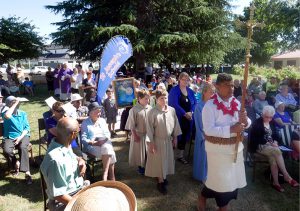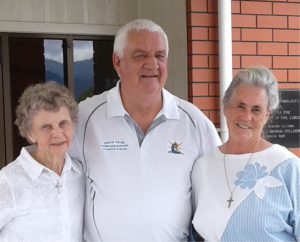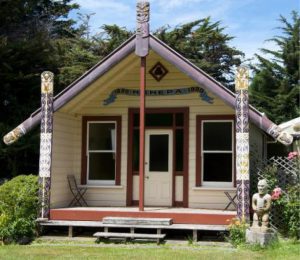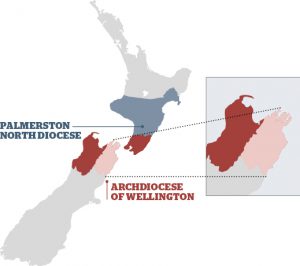 WelCom February 2018:
WelCom February 2018:
Te Whetū o Te Moana – the Star of the Sea
‘From the Sounds to the Sea, the Mountains to the Plains’
The amalgamated parish of Te Whetū o Te Moana – the Star of the Sea draws together a diverse range of town and rural communities across Marlborough and Kaikōura regions. This parish of seven Catholic communities stretches from Havelock and Picton in the north west, through Blenheim, the Awatere and on to Kaikōura in the south east. From the Tasman Coast on the east, the parish stretches more than 100km inland to Molesworth Cattle Station. Sunday communities range from about 12 parishioners in some places to 250 in another. Families come from a growing and widening cultural background and a broad mix of occupations including farming, horticulture, wine, education, fishing, local government, salt works, tourism, and retirement. Surrounded by sea, shadowed by mountains, traversed by rivers and plains, the area has a rich history and heritage of cultural diversity and strong faith communities.
Brief History
Prior to 1853: Fr O’Reilly, Wellington, first Catholic priest to visit Marlborough, Masses in Picton and Blenheim.
From 1853: Fr Garin sm, parish priest at Nelson, visits Marlborough district walking from Motueka.
1861: Fr Garin sm visits Kaikōura; on Sundays offered prayers for a group of Catholics and Protestants.
1864: St Mary’s Blenheim established by
Fr Sauzeau sm.
1865: St Josephs’ Church Picton, first Catholic church in Marlborough, blessed by Bishop Viard sm.
1865: St Mary’s Church and School, Blenheim opened.
1865: Catholic church at Havelock built by Fr Sauzeau sm.
1868: Church of St Michael opened at Kaikōura.
1869: Fr John Pezant sm ‘The apostle of Picton and the Sounds’ arrived in Blenheim parish as assistant to Fr Sauzeau sm.
1871: Havelock and Sounds separate parish from Blenheim Parish. Fr Pezant, parish priest, walked hills of the Sounds and Wairau to reach parishioners.
1876: Archbishop Redwood travelled by horse from Picton to Kaikōura, confirmed six children.
1878: St Mary’s wooden neo-Gothic Church in Blenheim opened.
1880s: Fr Melu sm, Ōtaki mission, calls at Mangamāunu and Ōaro, Kaikōura.
1881: Picton parish reunited with Blenheim, served by Marist priests for further 71 years.
1883: Fr Lampila appointed Kaikōura parish priest by Archbishop Redwood.
1883: St Joseph’s Catholic School Kaikōura opens, Miss Hollis as first teacher.
1890: Māori Catholic church built at Mangamaunu on land gifted by Parate and Ihaia Wahaaruhe. Opened by Archbishop Redwood, assisted by Fr Melu sm. Dedicated to St Francis De Sales.
1900: Sisters of Our Lady of the Mission from Christchurch arrive for school in Kaikōura.
1904: Seddon Church of the Immaculate Conception, Seddon, opened, officiated by Frs Lewis and Devoy of Wellington and Fr Servajean of Blenheim.
1908: Church of St Francis De Sales opened at Renwick.
1914: St Joseph School, Picton, set up by Sisters of Mercy from Wellington.
1919: Fr Fay sm built brick Sacred Heart of Jesus Church, Havelock, cost £2005 provided by Mr John Fitzpatrick.
1924: Fr Holley sm built brick school, Picton, and a new brick church, Havelock, opened and blessed by Archbishop Redwood.
1924: Archbishop O’Shea opens St Peter Chanel Church, Ward.
1952: Marists hand over missionary work in Sounds and Picton to Secular Clergy.
1960: Awatere (Seddon and Ward) separate parish from Blenheim.
1980: Awatere parish returned to Marists and served by priests from Blenheim.
2005: Society of Mary handed over Blenheim parish to Archdiocese.
2013: Seddon earthquakes damage St Peter Chanel Church at Ward. Deconsecrated and demolished in 2014.
2016: Newly amalgamated parish of Te Whetū o Te Moana – The Star of the Sea.
Te Whetū o Te Moana – the Star of the Sea
Fr John Pearce CP, Parish Priest
On 1 February 2016, Te Whetū o Te Moana, the Star of the Sea Parish was formed through the amalgamation of the churches and communities in Havelock, Picton, Renwick, Blenheim, Seddon, Ward and Kaikōura.
Two years later, we continue to consolidate and grow our new parish. Much of that is due to the dedicated people who have stepped up and helped to lead us. We know we have a long way to go, but we are growing and becoming stronger. Each community is a place of liturgical and pastoral life; is of service in a wider social community; and has a different identity.
At the time of the Second Vatican Council 1962‒65, Pope St John XXIII urged the Church to go back to its roots and to discover again, from its sources, the essentials of who she was, and who she was called to be. Here in Marlborough, we have taken this as a guide in rediscovering our past to build our present communities and to lead us into the future.
The Marist missionaries came to Marlborough from Wellington and Nelson and set up churches around the new settlements across the mountains and plains from Picton to Kaikōura. The Māori communities also grew.
Today, the Passionist missionaries from New Zealand and Australia are helping to grow our parish, working in partnership with parish leaders and parishioners.
I came to Marlborough from Australia a year ago. It’s my privilege to help with the parish’s new direction. I work alongside Fr Pat McIndoe who helped set up the amalgamated parish at the beginning. And throughout 2017 Fr Julian Wagg helped with pastoral needs in Kaikōura after the earthquake.
The Marist Missionary Sisters, Maureen and Frances Anna, arrived at Kaikōura last December to provide support; and the Mercy Sisters, Susanna and Elizabeth Mary, remain a constant presence in Blenheim.
But, the life and blood of all parishes are the people, the schools and their families; those who accept the invitation of the Lord to be his missionary disciples. Assisted in their mission by the Pastoral Council and the Parish Finance and Property Committee, our key leadership groups are the four Stewardship Teams: The Sounds: Picton and Havelock; Wairau: Blenheim, Renwick and the Plains; Tapuae-o-Uenuku: Seddon and Ward; and Sacred Heart: Kaikōura.
Mission Sisters in Kaikōura
Kathleen Ruck
Srs Maureen Connor smsm and Frances Anna smsm (Missionary Sisters of the Society of Mary), came to Kaikōura to re-establish a Religious presence as part of the pastoral outreach to the community affected by the 2016 earthquake.
They arrived 8 December, significantly for them on the Feast of the Immaculate Conception. Fr John Pearce cp and the congregation warmly welcomed the sisters at Mass the second Sunday of Advent. Before the final blessing, Fr John read letters of welcome from Cardinal John Dew and the Passionist Provincial Fr Tom McDoonugh. Morning tea at the hall extended the greeting.
At St Joseph’s School the following day, the sisters were welcomed with a pōwhiri by the principal Mrs Judith Ford, teachers, and pupils.
Sr Maureen, a teacher, has served in Samoa, the Chatham Islands, and the Solomon Islands and recently in Holy Cross Parish, Papatoetoe, Auckland. Sr Frances Anna, a nurse, has served in Fiji, the Chathams, Jamaica, Tanzania and Boston, USA. Both bring years of experience in working with people in many pastoral situations.
The Sisters work with the Sacred Heart pastoral team in Kaikōura to help in the recovery of the community after the trauma of the November 2016 earthquake.
As Marists, Srs Maureen and Frances Anna are called to be Mary’s presence in her simple way of loving and serving. They help with the service rosters, collaborate in the parish and the wider community
and offer a prayful presence and listening hearts.
Both Sisters feel blessed in having been called to this beautiful town and are so grateful for the warm welcome they have received.
Ministry Groups
The parish is very active with a wide range of ministry groups including:
- aged care and nursing;
- children’s ministry including Sunday Liturgy, Religious Education and the children’s Sacramental Team;
- cultural groups;
- an ecumenical and interfaith committee;
- family groups;
- ground maintenance;
- hospitality for Sunday morning teas and other events;
- liturgical ministries;
- youth and young adults’ ministries including junior and senior youth groups and a Young Church Mass;
- Justice and Peace Groups;
- social justice networks including the Social Justice Group, St Vincent de Paul Conferences in Blenheim and Picton, Young Vinnies at St Mary’s School, the Migrant Centre and seasonal workers’ support.
See the parish website www.staroftheseamarlb.co.nz to learn more.
Mercies on Mission
Sr Elizabeth Mary rsm
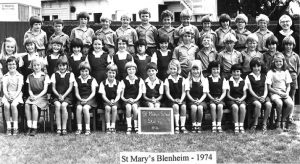
St Mary’s School, Blenheim 1974. Photo: mercy.schools.org.nz
Sisters of Mercy arrived in Blenheim in 1885 to put into practice an aspect of their founding charism – the Corporal and Spiritual Works of Mercy. This was reflected in our formal teaching in schools, and with music – a stalwart of the sisters in the past – but now not undertaken.
Our ‘numbers’ have reduced from the hay-days of the ‘60s and ‘70s, from 27 at St Joseph’s Convent in St Mary’s Parish to two now, living not in a convent but in a Blenheim household in Star of the Sea Parish.
Pope Francis has emphasised the Works of Mercy. The spiritual and corporal works – to which we are all called – are remain part of our Mercies on Mission. Together with prayer – formal, contemplative, group or alone – there is still a need to support, visit, comfort, share hospitality, instruct, mediate, listen, monitor, attend meetings and even agitate!
Here in our parish, some practical activities include: driving patients for the Cancer Society; driving for Meals on Wheels; visiting rest homes, the house-bound and the bereaved; attending Requiems in our churches as well as funerals in other churches and places; sewing and knitting; gardening; recycling; and sporting and games groups.
As ‘Mercies on Mission’ we answer a call to the God of Mercy’s love. And, like you, we are doing what we can for the good and welfare of others.
St Mary’s School Blenheim continues to thrive on its founding character instilled by the Mercy Sisters. Today St Mary’s School and pre-school communities, catering for boys and girls through to Year 8, are made up of children from a wide variety of cultures and from throughout the greater Marlborough region.
Stemming from its mission ‘In Christ’s Light: Caring, Confident Learners’ as a school community St Mary’s is committed to educating students to becoming Caring, Confident Learners while developing themselves, spiritually, academically, culturally and physically.
St Joseph’s School Kaikōura
Judith Ford, Principal
St Joseph’s School Kaikōura began in 1883 with Miss Hollis as the first teacher. By 1892, the school roll had grown to around 50 pupils.
The Sisters of Our Lady of the Mission arrived on the Whakatu on 9 January 1900, the same year as the new Sacred Heart Church opened. The Sisters lived and taught in the renovated St Michael’s Church that had been moved from the Kowhai.
A new purpose-built Convent School was opened in 1912. From then until 1980 a band of devoted Mission Sisters and lay teachers educated and taught music to hundreds of children. In June 1980, Archbishop Thomas Williams, opened and blessed the present school in Ludstone Rd. The original complex was later converted into ‘The Old Convent Bed and Breakfast’. Unfortunately, it was badly damaged in the 2016 earthquake.
With a roll around 90, our school continues its important role in our community by providing a Catholic education for our children.
Our school vision is ‘Growing Together in Faith, E tipu ake ana matou i te whakapononga, upheld by our ‘ARCH’ values: Achievement/Mana; Respect/Awhina; Confidence/Kaha Honesty/Oranga.
A New Mission in Picton Mission
Fr John Pearce cp
The closure of St Joseph’s School in Picton in 2017 has given Catholics of the Sounds Stewardship Area an opportunity to go back to basics and consider what our mission to the district might be. The property has potential and space for various forms of mission and for us to build up our community. For example, the school rooms provide a place for pastoral outreach, welcoming community groups seeking a place to meet.
This year, the community and the wider parish will be considering further how the buildings and property might better serve the mission, to ‘go and teach all nations, to baptise, and to remember’ for we believe the Lord is with us ‘always until the end of time’.
We are the inheritors of a great story of the spread of the Gospel into these lands in the late 1800s, by the French Marist Missionaries, and the spread of the Gospel and communities across Marlborough, ‘from the Sounds to the Sea (Kaikōura)’ that became three parishes, and now are one once again.
Rather than having a sense of closing down, our communities are considering ways we can open up our Church to the world. Our revised Sacrament Programme will be a start. Our community social activities will be another. Our building better bi-cultural relationships will be a third.
Kaikōura priest of compassion remembered
Much-loved priest Fr Eric Urlich, who died last September aged of 90, lived in Kaikōura for the last 15 years of his life. Of Croatian descent, before becoming a priest in 1981 he travelled the globe as a journalist, gathering stories, experiences and a ‘world view’ of people and their potential. As a priest, he served in parishes throughout the Archdiocese and was a Hospital Chaplain at Wellington Hospital and Mary Potter Hospice. Fr Michael McCabe spoke these words (abridged) at Fr Eric’s Requiem Mass at Sacred Heart Church Kaikōura.
Eric reminded us every day is an invitation from God to witness the beauty of creation, to respond to the grace of the changing seasons, and to pause before the majesty of God.
Eric loved creation – God’s garden – he called it. He was convinced that what happened in the seasons and in creation happened also in our journey of faith. Seasons of growth and harvest, seasons of cold and darkness, seasons of farewell and goodbye, and seasons of rebirth and resurrection.
Eric was a man of deep traditional prayer – he loved the Mass, the Rosary, the Divine Office. He was learned and widely read and wise. He could be blunt, stubborn, intransigent, but, equally, kind, generous, compassionate and loving. He gave his money to the poor, to charities, such as for refugees, Caritas, Women’s Refuge, the Missions, The Leprosy Foundation, the Nathaniel Centre.
Eric was a gifted preacher who maintained, ‘a good sermon was no longer than eight minutes!’ He was deeply loved and cherished by the people he served and maintained wonderful friendships across all walks of New Zealand society. His love of sports, sports talkback radio, racing and trotting was legend.
In the Church, we often confuse holiness with perfection and we tend to side-line those who are different, those who think and act differently. We overlook the fact that Jesus called people by name, and that, before he ever asked them to change, he accompanied them first. Jesus met them at their point of need, not his.
Eric was known as a priest of great compassion who was at home on the peripheries. That is where he made his greatest impression – with the sick, the frail, and the elderly. He had a great passion for justice and for the underdog and those on the margins, the poor, the migrant, the first generation New Zealander. Eric understood John Steinbeck’s saying that, ‘all people’s sins are attempted shortcuts to love.’ He understood why people, and how people, squandered grace, because he had also done that. But, rather than walk away from God or the Church, he responded to the grace of God by going even deeper into the mystery of God and the mystery of the Church and learnt to combine his faith with reason, his disappointment with hope, his stubbornness with compassion, and his hurt with a passion for justice.
The challenge Eric leaves us is to reflect on the seasons of grace in our own lives: If our souls have become stuck in the winter of unforgiveness he would encourage us to be reconciled. If our souls are lost in an endless summer of waste and excess, let us reflect on the ways Eric paused in prayer every day and during the day so that he never became too full of himself nor too despondent about God’s plans for him.
In the resurrection of Jesus we see the whole picture, the complete and completed Paschal story. Here we are able to let go of the foible, to relinquish the pathology, and to see the soul of Eric just as it was before God – loved, deeply loved and deeply loveable – a person who exhausted himself in priesthood and in service. In doing so, Eric reminded us all of a simple fact that our lives are shaped and reshaped by those who love us for these are the people who reveal the very face of God.
May Eric truly rest in peace.
Māori Catholic Pastoral Outreach
The first Catholic priest to visit the Blenheim/Kaikōura area was Fr Jeremiah O’Reily from Wellington who was serving the European community from 1843.
From 1844, French Marists, working among Māori from the mission at Pukekaraka at Ōtaki, travelled to meet, convert and instruct Māori over a wide area including the top of the South Island.
When Fr Antoine Garin was appointed to Nelson in 1850 as the first resident priest, he visited the Blenheim/Kaikōura area.
During his earlier missionary work in the Far North, Fr Garin had taken every opportunity to know, live with and inculturate into Māori society and became a fluent Māori speaker, which he continued throughout his mission.
During the restoration of the mission to Māori in the 1880s following the New Zealand land wars, clergy visited more regularly especially to the Kaikōura area. Maungamāunu was the main centre for a while with St Francis Church being built at the marae there in 1893 and a church at Ōaro in 1906. Hōhepa Waruhe or Waharuhe was a notable Māori katekita (catechist) based at Maungamāunu who built up the Catholic presence in that area at that time.
Pā Gerry Burns and Danny Karatea-Goddard of the Archdiocesan Māori Pastoral Care team visited the Tauihu o te Waka – the top of the South Island – during 2017, notably the Māori Catholic community in Kaikōura in the post-earthquake situation, and to reconnect and offer Miha Māori in Blenheim local whānau, parishioners, priests who wanted to experience the Mass in te reo Māori.
Danny says there is tremendous good will in the wider community, priests, religious, pastoral workers and parishioners to ensure our Māori identity is woven through parish outreach.
Kia tiaho tonu mai te Whetū o te Moana – May the Star of Sea continue to shine.
